
Vietnamese Grape Dragon: Superfood green product with great export potential
In the past 12 months, dehydrated sea grapes have recorded a revenue of 18.5 billion VND on domestic e-commerce platforms, showing a growth of over 8.32%. Not only known as a nutrient-rich superfood, Vietnamese sea grapes are also opening up promising export potential. With investment in technology and well-structured branding strategies, this product is expected to become a sustainable direction for Vietnam’s marine agriculture.
1. Discovering Sea Grapes: The Green Gift from Vietnam’s Ocean
Sea grapes, known as the “green vegetable of the sea,” are favored for their refreshing taste and abundant nutritional value. Beyond being a culinary delight, this seaweed is also a precious gift from the ocean. So, what exactly are sea grapes, and why are they often called the “green caviar” of the sea?
1.1. What Are Sea Grapes? Their Origin and Growth Characteristics
Sea grapes (scientific name: Caulerpa lentillifera, belonging to the Caulerpaceae family) are a type of seaweed that grows in small, grape-like chains of green bubbles, which is why they are commonly known as “sea grapes.”
They thrive in warm, clear, and saline waters, typically found in regions across East and Southeast Asia such as Japan, the Philippines, Micronesia, and Vietnam.
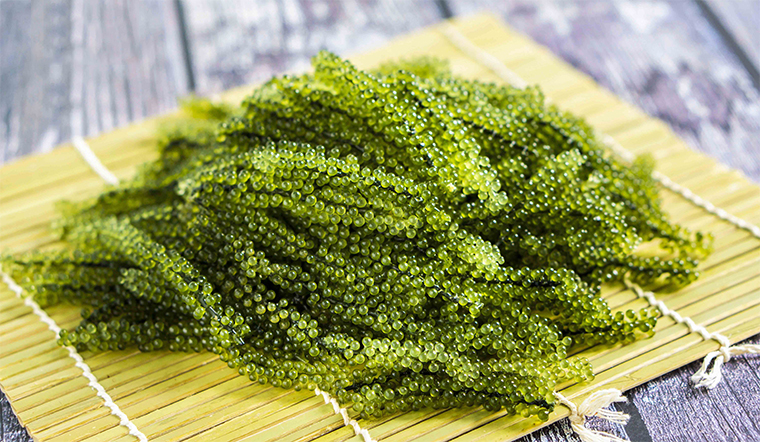
In Vietnam, sea grapes were first discovered naturally on Phu Quy Island (Binh Thuan Province) and are now widely cultivated in coastal provinces such as Khanh Hoa, Ninh Thuan, and Phu Yen. The ideal environment for their growth includes water temperatures between 22–28°C, salinity around 30‰, and a pH of 7.5–8, while avoiding direct sunlight.
Sea grapes grow quickly — only 25–30 days after planting, they can be harvested. Structurally, they have a main stem that anchors to rocks or sand with fine white root-like threads, from which small round “leaves” grow, filled with gel that gives sea grapes their signature crisp texture and oceanic flavor.
1.2. Why Are Sea Grapes Called the “Green Caviar” of the Ocean?
Sea grapes are nicknamed “green caviar” because of their appearance — clusters of small, round bubbles resembling fish roe. When eaten, they provide a crisp popping sensation with a mildly salty taste of the sea, creating a unique experience unlike any other vegetable.
Beyond their flavor, sea grapes are considered a “superfood” due to their abundance of nutrients such as protein, amino acids, vitamins A and C, and essential minerals like calcium, magnesium, zinc, and iodine. These nutrients help strengthen immunity, support heart health, beautify the skin, and are highly recommended by nutritionists as part of a healthy diet.
2. The Remarkable Health Benefits of Sea Grapes
Thanks to their natural nutrient profile, sea grapes help maintain overall health and prevent many modern illnesses.
2.1. Boosting Immunity and Overall Wellness
Sea grapes are rich in vitamins A and C, along with minerals such as zinc, iodine, calcium, and magnesium that enhance immunity, improve resistance, and fight oxidative stress in the body.
Their protein and omega-3 fatty acid content also helps reduce inflammation, maintain energy, and promote metabolism — making them ideal for recovery and overall vitality.
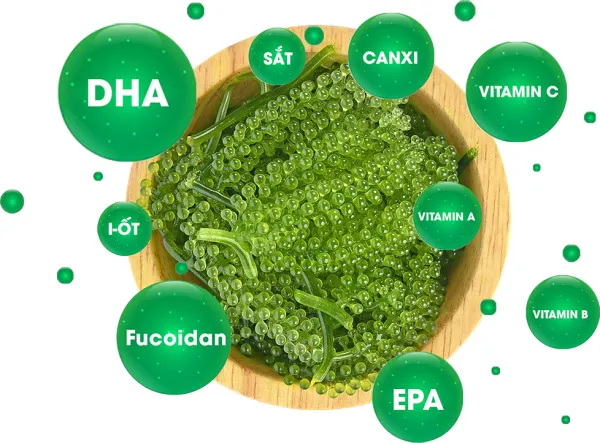
2.2. Supporting Weight Control, Skin Health, and Digestion
Low in calories but high in fiber and minerals, sea grapes are a great choice for people pursuing weight management or clean eating. Fiber aids digestion, prevents constipation, and promotes gut health.
Meanwhile, antioxidants and natural collagen in sea grapes improve skin elasticity, brighten complexion, and slow down aging — helping maintain both a fit body and healthy, radiant skin.
2.3. Helping Prevent Heart Disease, Diabetes, and Cancer
Sea grapes contain unsaturated fatty acids such as DHA, EPA, and bioactive compounds like fucoidan, proven to inhibit the growth of cancer cells. Vitamin C also helps control blood sugar and neutralize harmful free radicals. Together, these elements make sea grapes an effective natural food for preventing chronic diseases.
3. The Most Common Types of Sea Grapes
To meet growing consumer demand, sea grapes are now processed and distributed in various forms, with fresh and dehydrated (dried) sea grapes being the most popular. Each type offers distinct advantages in taste, nutrition, and convenience.
3.1. Fresh Sea Grapes – Natural Flavor and Nutrient-Rich
Fresh sea grapes are harvested directly from farms and preserved in clean seawater to retain their crispness and natural taste.
Before packaging, they are soaked for several hours in seawater pools to ensure top quality. Because they retain almost all natural vitamins and minerals, fresh sea grapes are highly popular in salads, sashimi, and seafood dishes. However, they have a short shelf life (3–5 days when refrigerated), so they should be consumed soon after purchase.
3.2. Dehydrated Sea Grapes – Convenient and Easy to Store
Dehydrated or “dried” sea grapes are made by removing most of the water from fresh sea grapes using drying or natural dehydration technology. This process extends shelf life to 6–8 months while maintaining most of the original taste and nutritional value.
To consume, simply soak them in cool water for a few minutes until they rehydrate and become plump and crisp again. Due to their convenience and longevity, dehydrated sea grapes have become a popular household item and an excellent choice for export and gifting.
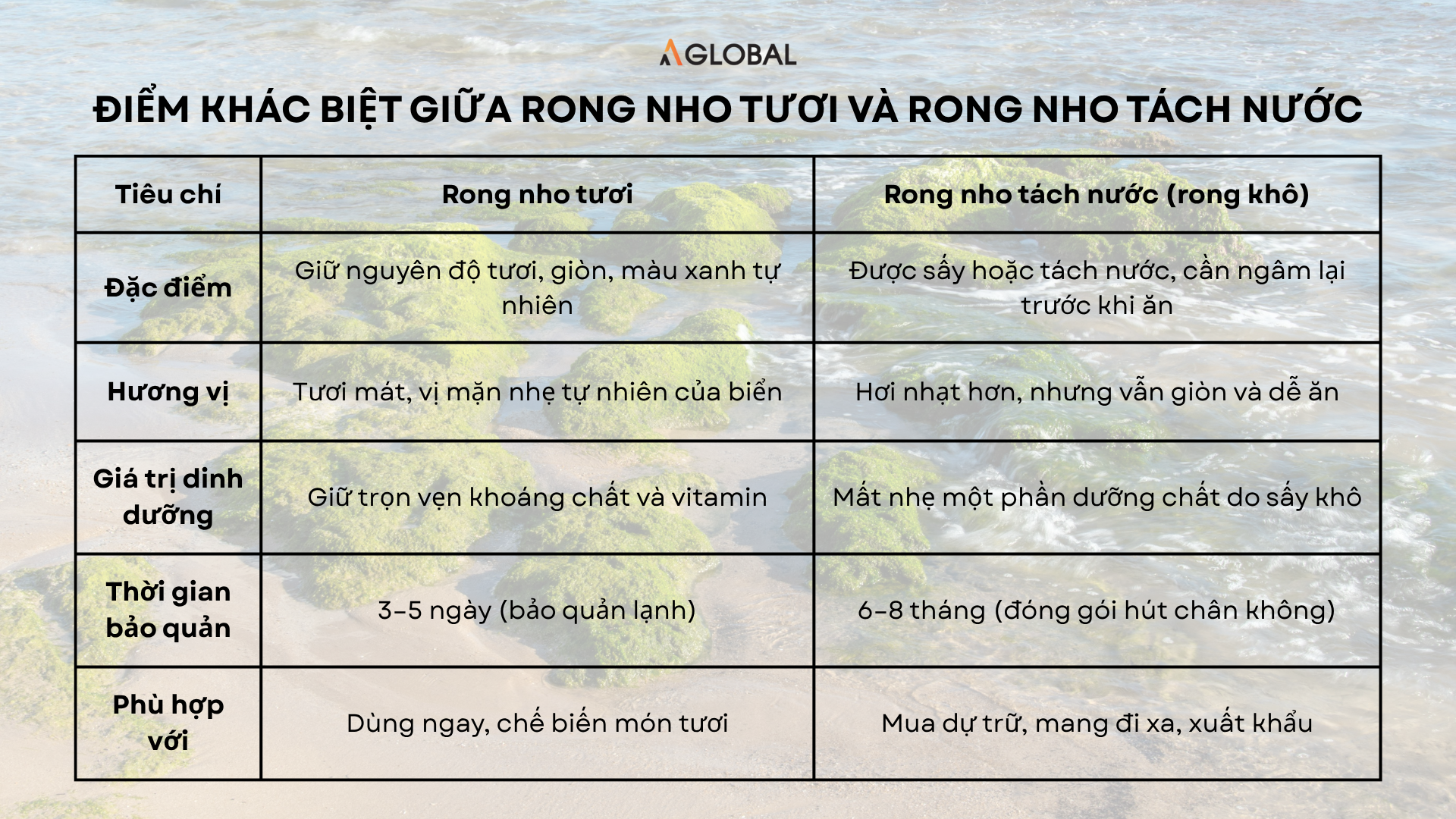
Differences between fresh seaweed and dehydrated seaweed
4. The Export Potential of Vietnamese Sea Grapes
With high nutritional value, sustainable farming practices, and growing global demand, sea grapes are opening a new chapter for Vietnam’s marine agriculture.
They not only generate stable income for coastal communities but also promote the image of Vietnam’s “green produce” to the world.
4.1. Global Market and Consumption Trends
Worldwide, the trend toward healthy, eco-friendly foods is growing rapidly — especially in countries like Japan, South Korea, the U.S., and across Europe. Sea grapes, often called “green caviar,” are gaining attention for their rich nutrition and versatility in cuisine.
Vietnam now exports sea grapes to more than 10 countries, notably Japan, Korea, the U.S., and China. In Khanh Hoa province alone, sea grape production accounts for about 10% of Vietnam’s total seaweed output, contributing significantly to marine product exports.
Beyond raw exports, processed sea grape products such as jellies, snacks, and beverages are also being welcomed by global consumers — creating opportunities for Vietnam to move deeper into the international value chain.
Read more: Bringing Vietnamese seaweed to the international market
4.2. Building and Developing the Vietnamese Sea Grape Brand
Besides their economic value, sea grapes are being developed as a green tourism product, offering visitors new experiences and helping local areas build distinct competitive advantages. This “agriculture–tourism” model not only enhances product value but also strengthens brand recognition for Vietnamese sea grapes globally.
As the world moves toward sustainable and eco-friendly products, investing in technology, closed-loop production, and strategic branding will be key to helping Vietnam’s sea grapes conquer international markets — affirming its position as a marine agriculture nation while providing long-term livelihoods for coastal communities.
Read more: Seaweed varieties in Vietnam: Export potential 2025
5. Successful Vietnamese Sea Grape Export Brands
In recent years, from Khanh Hoa to Ninh Thuan, many producers and processors have successfully brought Vietnamese sea grapes to international markets — including highly demanding ones such as Japan, the U.S., and South Korea.
5.1. D&T Khanh Hoa Seaweed
The story of D&T Khanh Hoa Seaweed Joint Stock Company, founded by Mr. Nguyen Quang Duy, is a testament to the potential of Vietnamese sea grapes. After over 10 years in the industry, he mastered the process of producing dehydrated sea grapes — a pioneering technology that extends shelf life and facilitates transportation.
D&T’s products, under the brands Okinawa and Vmax, now account for 70% of exports to the U.S. and Japan.
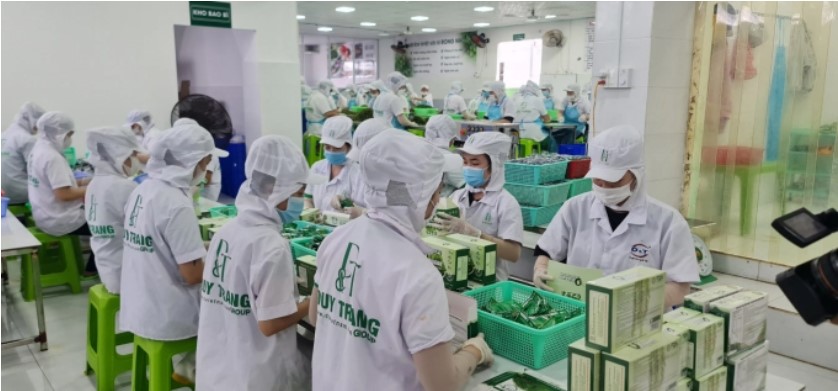
The company currently cooperates with more than 75 local households across Khanh Hoa, Phu Yen, and Ninh Thuan provinces, managing 75 hectares of cultivation and 10 product lines. This partnership provides stable employment for hundreds of coastal families, raising their average income to 35 million VND per hectare per month, while expanding clean, internationally certified raw material zones.
Read more: The largest seaweed growing and exporting enterprise in Vietnam
5.2. Truong Tho Sea Grapes
Truong Tho Sea Grapes Co., Ltd (Seagrapes Vietnam), founded by Mr. Tran Van Tuoi, is one of the pioneers in bringing Vietnamese sea grapes to the global e-commerce stage.

The brand successfully exported its products to the U.S. through Amazon, earning the Amazon’s Choice badge within just three months of launch. This recognition affirms the quality of Truong Tho’s sea grapes among international customers. The company has also registered trademark protection in the U.S., strengthening the global presence of “Made in Vietnam” agricultural products.
Read more: From A to Z how to sell on Amazon for beginners
Read more: Selling on e-commerce platforms: 8-step process
5.3. Tri Tin Sea Grapes
Tri Tin Co., Ltd (Khanh Hoa) represents a new generation of businesses focused on standardizing production processes and elevating local brand value. Its dehydrated sea grape products scored 95.8/100 OCOP points and have been nominated for National 5-Star OCOP certification.
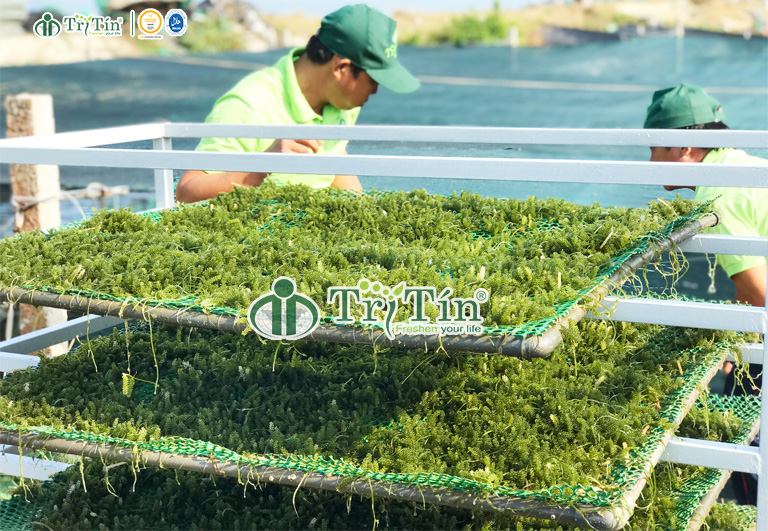
Currently, 80% of Tri Tin’s production is exported to demanding markets such as Japan, the U.S., South Korea, and Singapore. With an annual revenue of about 12 billion VND, Tri Tin has earned trust from both domestic and international consumers — proving the sustainable growth potential of Vietnam’s sea grape industry.
Read more: The province's first product is recommended for 5-star OCOP
6. Conclusion
The success stories of Truong Tho, D&T Khanh Hoa, and Tri Tin highlight the strong growth potential of Vietnam’s sea grape industry.
This momentum is a call for other businesses to invest boldly, enhance quality, and expand exports, bringing Vietnamese sea grapes further into global markets.
AGlobal – The leading cross-border e-commerce solution for Vietnamese businesses.
Register now for free 1-on-1 consultation tailored to your business field Here!
